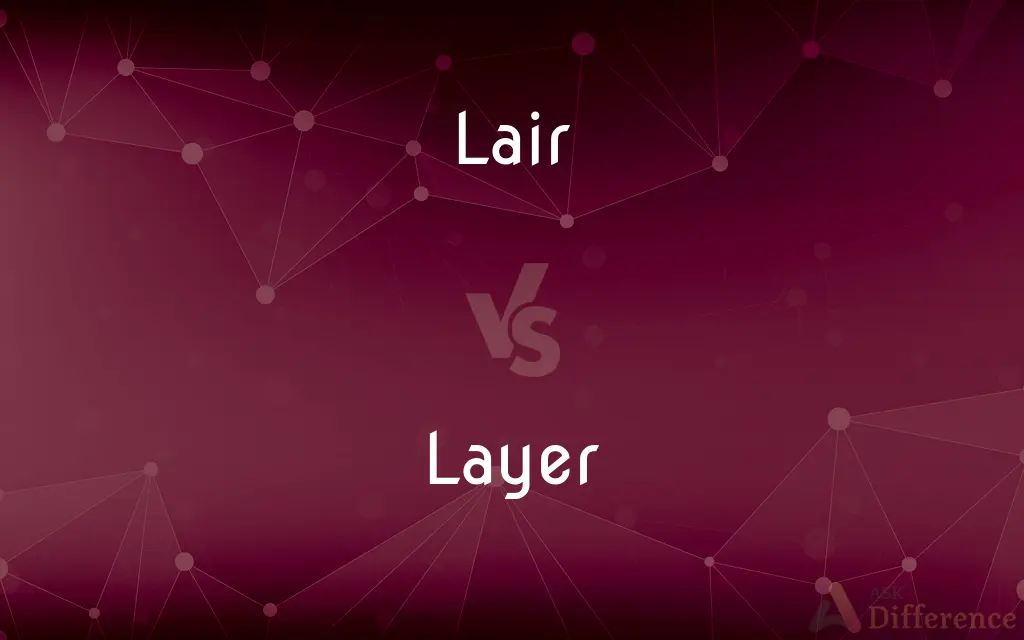Lair vs. Layer — What's the Difference?
Edited by Tayyaba Rehman — By Maham Liaqat — Updated on April 20, 2024
A lair is a specific term denoting a place where a wild animal lives, usually hidden; a layer refers to a sheet, coating, or level of material laid over or under another.

Difference Between Lair and Layer
Table of Contents
ADVERTISEMENT
Key Differences
A lair specifically describes the den or resting place of wild animals, emphasizing concealment and protection. On the other hand, a layer pertains to any of the different levels or coatings, either tangible like in cakes and geological sediments, or abstract like in software architecture.
Lairs serve as a refuge and safe space for animals to sleep, hide, or raise their young, typically designed to be discreet and protective against predators and elements. Whereas layers contribute to the structure and composition of various objects and systems, adding complexity or functionality through each added level.
In terms of construction, a lair is naturally or instinctually crafted by animals using surrounding materials to blend with the environment. Contrarily, layers are often deliberately created or formed, whether through natural processes like sedimentation or human actions like painting.
For example, a fox might use leaves and earth to construct its lair in a secluded forest area. On the other hand, a layer could refer to a stratum of rock in the earth’s crust or a layer of paint applied to a wall.
Understanding the concept of lairs is crucial in wildlife studies and conservation efforts, providing insights into the habits and needs of animals. In contrast, knowledge of layers is essential in fields ranging from geology and construction to software engineering and graphics design.
ADVERTISEMENT
Comparison Chart
Definition
Den or resting place of wild animals
Sheet, coating, or level laid over another
Usage
Specific to animal habitats
Broadly used in various contexts
Function
Protection and concealment
Adds structure, complexity, or functionality
Associated with
Animals and their natural environments
Multiple disciplines (e.g., science, tech, art)
Example
Bear cave in a forest
A coat of paint on a wall
Compare with Definitions
Lair
A wild animal's den or resting place.
The lion returned to its lair after hunting.
Layer
A sheet or level of material lying over or under another.
She added a layer of frosting to the cake.
Lair
A place of refuge or hideout, often hidden.
The bandits kept their treasures in a secret lair.
Layer
Can be both natural and artificial.
The atmosphere is composed of several layers.
Lair
Specifically used in the context of animal habitats.
Observers noted the entrance to a wolf's lair.
Layer
A stratum of a specific substance in a structure.
Geologists studied the layers of sedimentary rock.
Lair
Often natural or crudely constructed.
The rabbit had dug a lair under the old tree.
Layer
Used in various technical and everyday contexts.
The software's architecture includes several layers of security.
Lair
Used metaphorically to describe a retreat or sanctuary.
He retreated to his lair, his home office, to work undisturbed.
Layer
Refers to depth or complexity.
The novel's narrative has many layers of meaning.
Lair
The den or dwelling of a wild animal.
Layer
A sheet, quantity, or thickness of material, typically one of several, covering a surface or body
Arrange a layer of aubergines in a dish
Lair
A den or hideaway.
Layer
A person or thing that lays something
The majority of fish are egg-layers
Lair
(Obsolete) A resting place; a couch.
Layer
A shoot fastened down to take root while attached to the parent plant
They can be increased from cuttings and layers
Lair
A place inhabited by a wild animal, often a cave or a hole in the ground.
Layer
Arrange in a layer or layers
The current trend for layered clothes
Lair
A shed or shelter for domestic animals.
Layer
Propagate (a plant) as a layer
A layered shoot
Lair
(figuratively) A place inhabited by a criminal or criminals, a superhero or a supervillain; a refuge, retreat, haven or hideaway.
Layer
One that lays
A tile layer.
Lair
A bed or resting place.
Layer
A hen kept for laying eggs.
Lair
(Scotland) A grave; a cemetery plot.
Layer
A single thickness of a material covering a surface or forming an overlying part or segment
A layer of dust on the windowsill.
A cake with four layers.
Lair
(Scotland) A bog; a mire.
Layer
A usually horizontal deposit or expanse; a stratum
Layers of sedimentary rock.
A layer of warm air.
Lair
A person who dresses in a showy but tasteless manner and behaves in a vulgar and conceited way; a show-off.
Layer
A depth or level
A poem with several layers of meaning.
Lair
(Britain) To rest; to dwell.
Layer
(Botany) A stem that is covered with soil for rooting while still part of the living plant.
Lair
(Britain) To lay down.
Layer
An item of clothing worn over or under another.
Lair
(Britain) To bury.
Layer
To divide or form into layers
Layered gravel and charcoal to make a filter.
Lair
To mire.
Layer
To cut (hair) into different, usually overlapping lengths.
Lair
To become mired.
Layer
(Botany) To propagate (a plant) by means of a layer.
Lair
A place in which to lie or rest; especially, the bed or couch of a wild beast.
Layer
To wear (clothing) in layers.
Lair
A burying place.
Layer
To form or come apart as layers.
Lair
A pasture; sometimes, food.
Layer
(Botany) To take root as a result of layering.
Lair
The habitation of wild animals
Layer
A single thickness of some material covering a surface.
Wrap the loaf in two layers of aluminum foil before putting it in the oven.
After the first coat of paint dried, he applied another layer.
Layer
An item of clothing worn under or over another.
It's cold now but it will warm up this afternoon. Make sure you wear layers.
Layer
A (usually) horizontal deposit; a stratum.
I find seven-layer cake a bit too rich.
Layer
One of the items in a hierarchy.
Mired in layers of deceit
Layer
One in a stack of (initially transparent) drawing surfaces that comprise an image; used to keep elements of an image separate so that they can be modified independently from one another.
Layer
A person who lays anything, such as tiles or a wager.
Layer
A mature female bird, insect, etc. that is able to lay eggs.
When dealing with an infestation of headlice, the first step is to eliminate the layers.
Layer
A hen kept to lay eggs.
Layer
A shoot of a plant, laid underground for growth.
Layer
(ambitransitive) To cut or divide into layers.
Layer
(ambitransitive) To arrange in layers.
Layer the ribbons on top of one another to make an attractive pattern.
Layer
One who, or that which, lays.
Layer
That which is laid; a stratum; a bed; one thickness, course, or fold laid over another; as, a layer of clay or of sand in the earth; a layer of bricks, or of plaster; the layers of an onion.
Layer
A shoot or twig of a plant, not detached from the stock, laid under ground for growth or propagation.
Layer
An artificial oyster bed.
Layer
Single thickness of usually some homogeneous substance;
Slices of hard-boiled egg on a bed of spinach
Layer
A relatively thin sheetlike expanse or region lying over or under another
Layer
An abstract place usually conceived as having depth;
A good actor communicates on several levels
A simile has at least two layers of meaning
The mind functions on many strata simultaneously
Layer
A hen that lays eggs
Layer
Thin structure composed of a single thickness of cells
Layer
Make or form a layer;
Layer the different colored sands
Common Curiosities
Are all animal homes considered lairs?
Not all animal homes are considered lairs; lairs specifically refer to the dens or hideouts of wild animals, particularly those used for protection and concealment.
How do the concepts of lairs and layers differ in their construction?
Lairs are typically constructed instinctually by animals using natural materials, whereas layers are formed or assembled in both natural processes and by deliberate human action in various contexts.
Can "layer" refer to something intangible?
Yes, "layer" can refer to intangible things, such as layers of security in software or layers of meaning in a story.
What might be considered a layer in nature?
In nature, a layer could be a stratum of rock, a level of the atmosphere, or layers of vegetation in a forest canopy.
How does understanding lairs help in wildlife conservation?
Understanding the location, structure, and importance of lairs helps in wildlife conservation efforts by providing insights into animal behaviors and needs, aiding in habitat protection.
What are the implications of layers in graphic design?
In graphic design, layers are crucial for creating complex images, allowing designers to work with and manipulate individual components independently.
Can layers affect the performance of software systems?
Yes, the number and complexity of layers in software systems can significantly affect their performance, impacting processing speed and resource utilization.
What is the primary purpose of a lair for animals?
The primary purpose of a lair is to provide animals with a safe and concealed space for resting, hiding, or raising their young.
What is a common use of the term "layer" in technology?
In technology, "layer" commonly refers to different levels of abstraction or components in software and networking architectures.
What distinguishes a lair from a typical animal shelter like a nest?
A lair is often larger, more secluded, and used primarily by predatory or larger wild animals, whereas nests are typically smaller, constructed by birds or small mammals, often for laying eggs and raising offspring.
Is there an overlap in the use of lair and layer in any context?
There is generally no overlap in usage; lair is specific to animal habitats, while layer has broad applications in multiple fields including science, technology, and the arts.
How can the concept of layers apply to human psychology?
Layers in human psychology might refer to layers of consciousness or levels of emotional depth, influencing behavior and interactions.
What role do layers play in geological studies?
Layers are fundamental in geological studies as they reveal the historical sequence of Earth’s geological events and help predict future geological phenomena.
How is the concept of layers utilized in fashion design?
In fashion design, layers are used to create visual depth and practical adaptations, such as for different weather conditions, enhancing both the aesthetic and functionality of clothing.
How does the construction of a lair differ from human-made shelters?
The construction of a lair is typically more instinctual and integrated with the environment, using available natural materials, unlike human-made shelters which are often planned and built with manufactured materials.
Share Your Discovery

Previous Comparison
Ultrafiltration vs. Filtration
Next Comparison
Physician vs. PhysiotherapistAuthor Spotlight
Written by
Maham LiaqatEdited by
Tayyaba RehmanTayyaba Rehman is a distinguished writer, currently serving as a primary contributor to askdifference.com. As a researcher in semantics and etymology, Tayyaba's passion for the complexity of languages and their distinctions has found a perfect home on the platform. Tayyaba delves into the intricacies of language, distinguishing between commonly confused words and phrases, thereby providing clarity for readers worldwide.
















































